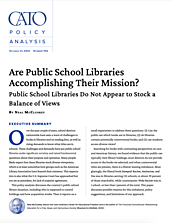This policy analysis discusses the country’s public school library situation, including who is supposed to control holdings and how acquisition works. Then it reports on a small experiment to address three questions: (1) Can the public see which books are in libraries; (2) do libraries contain potentially controversial books; and (3) can students access diverse views?
Searching for books with contrasting perspectives on race and American history, we found evidence that the public can typically view library holdings; most districts do not provide access to the books we selected; and when controversial titles are present, there is a liberal-leaning imbalance. Most glaringly, the liberal book Stamped: Racism, Antiracism, and You was in libraries serving 135 schools, or about 39 percent of those searchable, while counterpoint Woke Racism was in 1 school, or less than 1 percent of the total. This paper discusses possible reasons for this imbalance, policy suggestions, and limitations of our approach.



